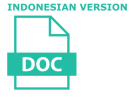The Analysis of Compound Sentence Formation in Moon Jae-In's Posts on Social Media Instagram: An Effort to Increase Writing Skills of Korean Language Education Students UPI
Jayanti Megasari(1*), Velayeti Nurfitriana Ansas(2), Arif Husein Lubis(3), Didi Sukyadi(4), Adisty Dyva Restiseptya(5), Thrisa Ananda Putri(6)
(1) Universitas Pendidikan Indonesia
(2) Universitas Pendidikan Indonesia
(3) Universitas Pendidikan Indonesia
(4) Universitas Pendidikan Indonesia
(5) Universitas Pendidikan Indonesia
(6) Universitas Pendidikan Indonesia
(*) Corresponding Author
Abstract
This research is on the formation of compound sentences in Korean, as seen from the uploads on Instagram of former South Korean President Moon Jae-in. On his Instagram, Moon Jae-in uploads photos, videos, and writings containing ideas and responses to things. Researchers see the need to develop writing skills in the Korean Language Education Study Program FPBS UPI. Therefore, the researcher wants to see how Korean speakers form compound sentences according to Korean grammar. As a president, Moon Jae-in is considered able to write in Korean grammar so that it does not cause ambiguity and misunderstanding. The research data found 76 posts by Moon Jae-in and 267 compound sentences. This study also classifies these compound sentences into two classifications, namely 내포문 [nae-pho-mun] 'embedded clause' and 접속문 [jeop-sok-mun] 'conjunctive sentence.' The analysis results show two categories of compound sentence formation patterns in Moon Jae-in's writings: patterns of stacked and non-stacked compound sentence formation. After the analysis was completed, the researcher concluded three strategies for learning to write, namely 1) Students must be able to determine the type of sentence to be made; 2) Students must pay attention to sentence patterns in Korean; and 3) Learners must be careful in choosing the correct grammar.
Keywords
Full Text:
PDFReferences
Asri, D. (2020). Modalitas dalam Pidato Kampanye Calon Presiden Republik Korea (문제인) Pada Tahun 2017. S1 thesis, Universitas Pendidikan Indonesia, dilihat 20 Maret 2022, < http://repository.upi.edu/id/eprint/57927>.
Chaer, A. (2007). Linguistik Umum.Jakarta: Rineka Cipta.
Choi, G.S. (2009). 한국어 통사론 입문 [Introduction to Korean Syntax]. Seoul: Pjbook.
Creswell, J. W. (2019). Research Design Pendekatan Metode Kualitatif, Kuantitatif dan Campuran. Yogyakarta: Pustaka Pelajar.
Dalman. (2015). Menulis karya ilmiah. Depok: Rajagrafindo Persada.
Deung, Y. (2016). A study on the education of the comprehension of Korean complex sentences: focusing on Chinese advanced learners (Master's thesis, Graduate School of Chung-Ang University, Majoring in Korean Language and Education). Seoul: Graduate School of Chung-Ang University.
Ho, P. T. (2004). Current Status and Improvement of Elementary School Writing Education. New Language Life, 47-68.
Jang, M.R. (2012), 한국어 복문 사용 능력 향상을 위한 문법 교육에 대한 연구 -명사절의 교육 내용 선정과 배열을 중심으로[A Study on Grammar Education Method to Enhance the Ability of Using Korean Complex-Compound Sentence -Focus on Selection and Arrangement of Education Content of Nominal Clause], 한국어교육[Journal of Korean Language Education], vol.23, no.2, 331-359.
Jang, M. R. (2018). A Study on Cohesion in Complex Sentencesfor Reading and Writing in Korean Language Education. The Review of Korean Cultural Studies, 64(64), 195-220. https://doi.org/10.17329/kcbook.2018.64.64.007
Jang, M.R. (2008). 문장 구조 중심의 한국어 교육 연구 [(A) Study on Korean Language Education Focusing on Sentence Structures], Kyunghee University, dilihat 20 Maret 2022, < https://academic.naver.com/article.naver?doc_id=31058380>.
Jein Thi Thain. (2015). A Study on Contrasting Word Order In Korean And Vietnamese: Focusing on Word Order of Sentence Components and Word Order Of Phrases, Dongshin University, dilihat 15 Maret 2022, < http://www.riss.kr/link?id=T13811632&outLink=K>.
Ho, Y. (2020). Understanding the Linguistics of Korean as a Foreign Language. Seoul: Sotong.
Kim, J.S., dkk. (2019). Korean Grammar for Foreign 2. Seoul: CommunocationBooks, Inc.
Kim, Y.K. (2012) 문장 구조(어순)와 의식 구조 사이의 상관관계: 한국어와 영어 비교 연구 [Inter-relationship between sentence structure (word order) and cultural structure: A case study in Korean and English], 영미연구 [Journal of British & American Studies], 27, 271-302.
Kridalaksana, H. (2001). Kamus Linguistik: Edisi Ketiga, Jakarta: Penerbit PT Gramedia Pustaka Utama.
Park, M.S. (2014). 문장 생성 능력 향상을 위한 한국어 문장 교육 내용 연구[The Study on the Contents of Korean Sentence Education for Enhancing Sentence Production Ability], 이중언어학 [The Korean Society of Bilingualism], 57, 49-74.
Seop, L, I. (2016). Introduction to Korean Language Studies. Seoul: Hak Yeon Sa
Suk, K, J. ( 2005). Korean grammar for foreigners 1, Seoul : Communication Books (Ju).
Supriyadi. (2014). Sintaksis Bahasa Indonesia. Gorontalo: UNG Press.
Tarigan, H. G. (1987). Pengajaran Keterampilan Berbahasa. Bandung: Angkasa.
Yeon, J. D, 2015, A study on improving teachers’ ability of teaching writing in Korean as an L2. Foreign Language Education Research, 18, 148-166.
Yoo, H.W. (2009). 한국어 구문분석 방법론 연구 - 복문 구조 분석을 중심으로 -The Study on the Methodology of The Korean Parser. 민족문화연구[Korean Cultural Studies], 50, 153-182.
Article Metrics
Refbacks
- There are currently no refbacks.
Copyright (c) 2024 JLA

This work is licensed under a Creative Commons Attribution-ShareAlike 4.0 International License.







